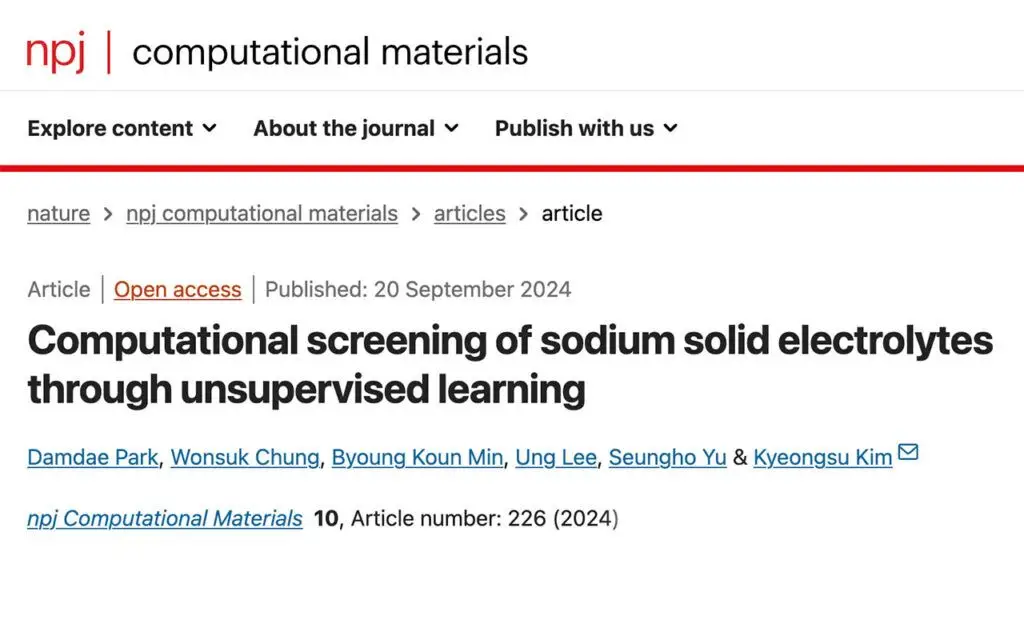A recent study harnesses the power of unsupervised machine learning combined with ab initio molecular dynamics simulations to computationally screen and identify potential high-conductivity sodium-solid-state electrolytes. The study addresses the urgent need for advanced energy storage solutions by focusing on all-solid-state batteries (ASSBs). While lithium-ion solid-state electrolytes (SSEs) have seen extensive research, concerns over lithium’s limited global availability have driven interest toward sodium-ion alternatives. However, sodium-ion SSEs currently suffer from low ionic conductivity at room temperature, posing challenges to their practical application and commercialization.
Data-Driven Approach for Material Discovery
To mitigate the limited experimental data on sodium-ion SSEs, the researchers employed unsupervised machine learning techniques to identify promising high-conductivity materials. The methodology encompassed:
- Dataset Compilation and Feature Engineering: A comprehensive dataset of 12,670 sodium-containing materials was sourced from the Materials Project database. Each material’s structure was simplified and encoded into a high-dimensional feature vector using 20 structural descriptors, alongside attributes like lattice volume and space group, resulting in a feature space of 9,811 dimensions.
- Unsupervised Clustering with HDBSCAN: Hierarchical Density-Based Spatial Clustering of Applications with Noise (HDBSCAN) was utilized to categorize the materials into 13 distinct groups based on structural similarities. This clustering aimed to isolate groups with potential high ionic conductivity.
- Candidate Selection via Ab Initio Molecular Dynamics (AIMD): From the identified promising clusters, candidates were selected for further evaluation using AIMD simulations. The mean squared displacement (MSD) of sodium ions was analyzed to infer ionic conductivity, effectively narrowing down the most viable SSE candidates.
- Identification of Key Structural Descriptors: Decision tree classifiers were trained on the feature vectors of the promising groups to determine the key structural descriptors that correlate with high ionic conductivity, enhancing the understanding of the mechanisms driving ion mobility.
Key Findings and Insights
- Promising Material Groups Identified: The clustering revealed that Groups 5AB (NASICON-type structures) and 7UV (sodium chalcogenides) are the most promising for high ionic conductivity. These groups share characteristics such as the presence of spacious ion channels and the absence of highly electronegative elements like oxygen, which facilitate sodium ion migration.
- Validation through AIMD Simulations: AIMD simulations confirmed that materials within Groups 5AB and 7UV exhibit significantly higher MSD values, indicating superior ion diffusivity compared to other groups. This validation underscores the effectiveness of the clustering approach in identifying potential high-conductivity SSEs.
- Structural Descriptors Correlating with Conductivity: The analysis identified key descriptors, including specific mXRD peak intensities and angular distribution functions, that are instrumental in characterizing high-conductivity groups. For instance, Group 5AB is characterized by a high content of tetrahedral XO₄ structures and particular angular distributions conducive to ion mobility.
- Successful Out-of-Sample Prediction: The framework was successfully applied to a recently studied NASICON-type material, accurately predicting its high ionic conductivity. This demonstrates the framework’s capability to evaluate new candidates efficiently without extensive computational resources.
Implications for Sodium-Ion SSE Development
The study highlights that high ionic conductivity in sodium-ion SSEs is intrinsically linked to specific structural features that facilitate ion migration. The presence of large ion channels and the exclusion of highly electronegative elements are crucial factors. The developed framework not only accelerates the discovery of new SSEs but also provides valuable insights into the structural prerequisites for high conductivity, guiding future experimental and computational efforts.
Future Directions and Applications
The research presents a scalable and systematic approach for discovering sodium-ion SSEs, which can be extended to other ion-based electrolytes like lithium and potassium. The integration of unsupervised learning with AIMD simulations offers a robust tool for rapidly screening and identifying promising materials, potentially leading to breakthroughs in all-solid-state battery technologies. Additionally, incorporating generative models and data augmentation techniques could further enhance the framework’s predictive power and applicability.
By leveraging unsupervised machine learning and AIMD simulations, the study effectively identifies and characterizes promising sodium-ion solid-state electrolytes. The findings not only advance the understanding of the structural factors influencing ionic conductivity but also provide a powerful framework for accelerating the discovery of next-generation materials for all-solid-state sodium-ion batteries.
Reference: Nature Computational Material
Park, D., Chung, W., Min, B.K. et al. Computational screening of sodium solid electrolytes through unsupervised learning. npj Comput Mater 10, 226 (2024). https://doi.org/10.1038/s41524-024-01392-6
















